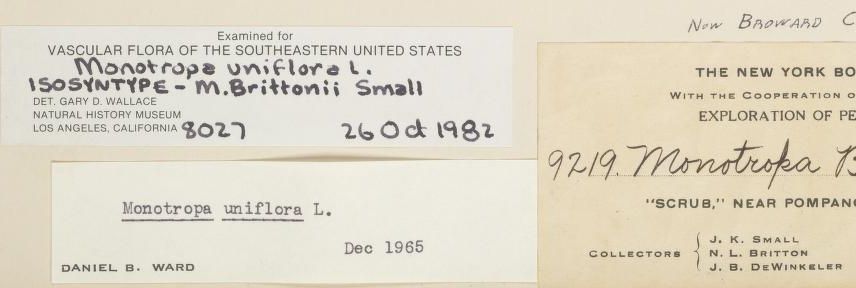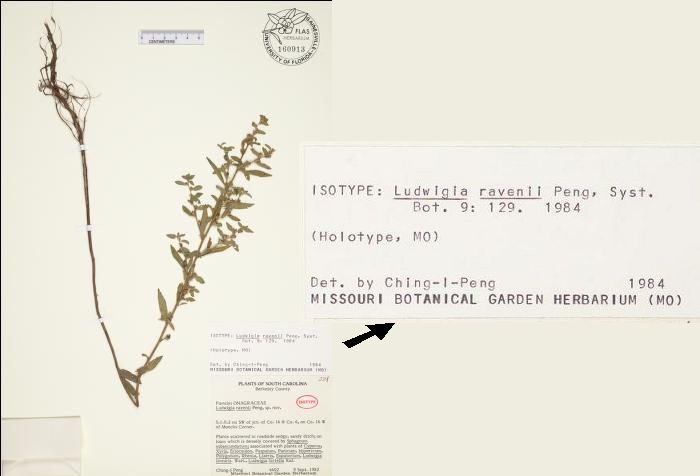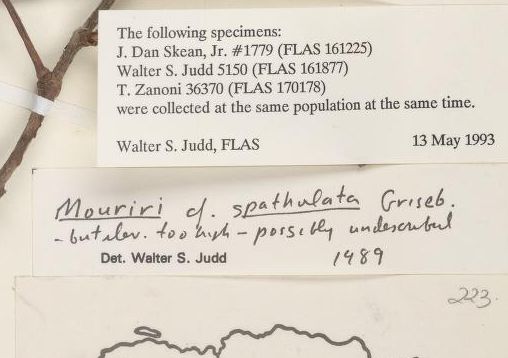Introduction
The value of herbarium specimens are improved by careful annotation. Annotations bring the scientific names of specimens up-to-date to conform with current species concepts. This helps herbaria organize their collections and they are an integral part of curatorial management. Annotations also document the use of specimens in research studies. This cross-referencing is integral to the scientific method and is important for future researchers.
Annotation is the courtesy expected by the lending institution for the cost of processing and mailing loans and the wear and tear on the specimens. This conforms to a long-standing tradition (Report of the committee for recommendations in desirable procedures in herbarium practice, II. Brittonia 25: 307-310. 1973).
The Annotation Slip
An annotation slip should be composed of archival paper (acid-free). All marks are to be typewritten or be made in permanent ink. Ballpoint pen and felt tip pen are not to be used as they are not permanent. Pencil is permanent, but erasable. Some institutions allow pencil to be used and others do not. Slips are usually approximately 1″ X 4″, but may be larger or smaller depending on the information included. It is best to economize on space since herbarium sheets have limited free space. The following are recommended settings for a word processing document:
- 0.5″ margins all around
- 2, 3 or more columns, depending on how long the names are and if there are var. etc.
- 8-10 pt. easy-to-read font, 9 pt. is probably the sweet point, depending on the font you choose
(note: annotations for bryophyte and lichen packets should be as small as possible) - paragraphs: 6 pt after, keep together, keep with next except for the last line which is typically your name or project name
- by formatting in this manner an annotation will never break across a column
- the taxon name line should be on the first line and in bold with genus and specific epithet (etc.) in italics or underlined
- if there is a project title line it may go below the determiners name or at the top of the annotation. Generally, it could be in the next smaller font, but some people capitalize it and make it bigger.
As a general rule, annotations should not be written directly on herbarium sheets and NEVER written on other annotations or the original label. In rare cases, institutional staff pencil on annotations to reflect synonymic name changes. Borrowed specimens should always be annotated with added slips (see placement and attachment below).
 The Information
The Information
The annotation slip should usually include the following information (except when documenting use of a specimen in a procedure):
- the name of the taxon* including the authority,
- the name of the investigator,
- the date (at least the year) of the identification.
Numerous other types of information may be included on annotation slips, such as:
- the herbarium acronym and/or institutional name (e.g., University of Florida Herbarium (FLAS)
- the title of the study,
- location of duplicate specimens,
- citation of references about the species or specimen,
- special comments or additional information about the specimen.
* If the annotation is being generated for curatorial management to reflect a name changed based on synonymy and the person making the change is not actually identifying the specimen, an equal sign should be placed in front of the name.

When a researcher completely agrees with the previous scientific name on a specimen an exclamation point, “stet” or “teste” are sometimes used in place of the name. This shorthand method is useful when a researcher is examining large numbers of specimens. It can create confusion when not placed next to the previous identification, where there are already multiple annotations on the sheet, or the original name is not particularly clear. Given that annotations may be generated via computer fairly efficiently, this practice is discouraged.

The annotation may also document the use of a specimen in a special procedure (e.g., destructive analysis) even when updated taxonomic information is not provided.




Type Specimens
Type specimen annotations require more detail than most other annotations. Guidelines for annotating type specimens may be found in Annotation of Type Specimens: Recommendations.
Placement and Attachment
Herbaria may have certain preferences as to how and where annotations are attached to specimens. The policies in this connection may be conveyed when visiting an institution or with paperwork accompanying a loan. For example, Geneva (G) wants slips to be pinned on and Stockholm (S) has specific positioning preferences.
Standard practice is to place annotations in a blank space as near to the original label as possible. This is usually to one side or above the label and flush with the right side of the sheet. If other annotations are present, it is best to position the new one above the most recent, unless it will not fit or the most recent is in a very unusual position. When there is not sufficient blank space, an annotation may be glued only at one end and overlap mounted plant material.
Please note that some lending institutions do not wish for annotation slips to be affixed (Geneva (G), for example). Consult the rules of the lending herbaria for information in regards to this or follow the practice that seems to be consistent with the specimens borrowed from each institution.
Annotations are usually attached with an archival, pH-neutral glue. Institutions may specify which glue to use and not to use. Polyvinyl acetate white glue, DucoCement and methyl cellulose glues are typically acceptable. The archival qualities of glue sticks are debated. Rubber cement should not be used since it is not permanent. Glue should be applied only to each or one end of the annotation. This will allow you to pull off the slip if a mistake is made.
Examples of Annotations
Very basic annotations


Stacked and positioned to left of label

Positioned above the label

Stacked and positioned above the label, one with informative information.

Project designation and affiliated institution provided on annotation.

